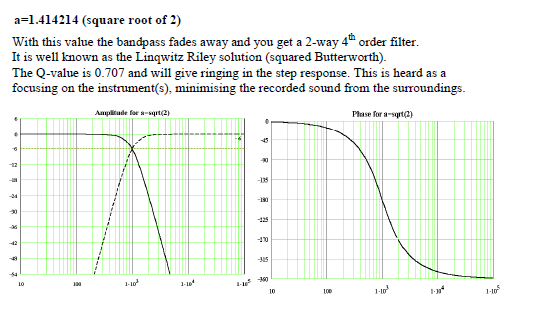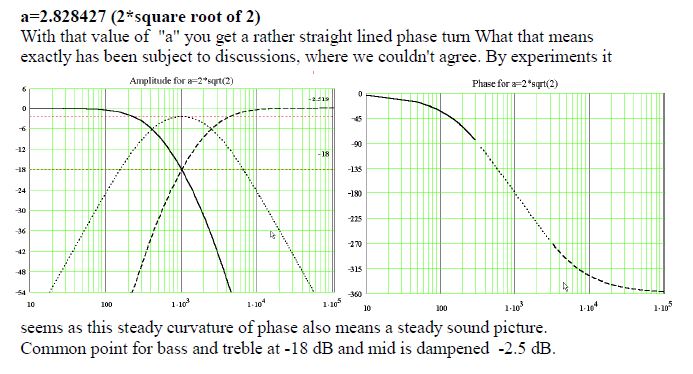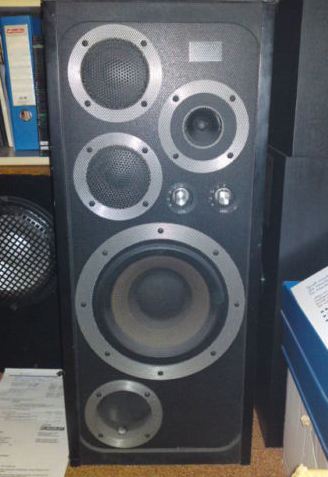Hi members
I want to know more about speakers and have a more complete knowledge about how they work and why they do the things they do. To get a better hold on this, I think designing a pair of different speakers is mandatory. Specially when it comes to passive crossovers. The idea isn't to be an expert, as that is impossible, but I do want to know why different ways to the end goal is used, and what positives and negatives these desicions have.
As such, I'm designing and building a smaller 2/2.5way stand mounted speaker, that after finishing most probably will be taken apart and parts reused as a 3-way, as 2-ways doesn't really do it for me. I always find 3-ways sounding superior according to my own ears. Why, I really don't know at this stage, but hopefully I will know in a year or so. Eh, or atleast have an idea of why
Anyway, in this planning stage, I do want some input on how to configure the lower end of a 3-way the best possible way.
The starting concept of this 3-way were, and preferably still are a very usual setup of a tweeter, either 1 or 2 4-5" mids and a woofer section of 2 8" woofers. I find this to be sufficient in output to my needs, and allows a nice looking speaker. But, there are other ways of doing this, obviously, and I have somewhat fallen in love with the idea of maybe using one single larger woofer sidemounted. What would you have done, and why?
The speakers are going to have around 80-90L available for the woofer section, and the crossover to the mid will be somewhere between 200 and 400hz, crossed to a polypropylene or glass fibre coned midrange. The woofer section are to be either ported with a F3 at or lower than 30hz, or sealed with a Qtc of lower than 0.7 preferably more around 0.6 and a low and usable F3. The speaker are going to be placed close to the wall for aestetichs and hopefully to compensate for baffle step loss a bit, but the baffle would still end up at around 40-50cm from the wall. This close placement to the wall, makes the concept of sidemounted woofer possibly even better, as it could/would be playing in 2pi?
Another point of much consideration havee been the placement of the woofers, if on the front baffle, is up under the midrange or down low at the floor the best placement?
Sidemounted, I guess low down is the best placement?
I can't really decide on going ported or sealed, they both have their negatives and positives, but I think if going with a single larger sidemounted woofer would be more suited towards sealed and vice versa. But, the Sd/Vd doesn't really change that much, or end up lower going with a single larger driver, so this point aren't really valid.
I would prefer a sealed section, but it seems like getting a pair of 8" drivers or one 10-15" woofer down to 0.6 Q is requiring a larger volume than what I've intended to go with, but maybe you guys now of some drivers I don't know about?
I would like your input on how you've would have done it, and why you think that way are the best possible. I also would like to get tips on drivers that suits these goals. I have limited time to play on a pc, still, so if you've simulated something at around this size and configuration, please tell the results. The only Android app that I've found to simulate boxes with seems to be fiercely wrong at calculating boxes.
When it comes to midrange sensitivity and spl, we'll, I haven't really decided on a midrange or configuration to use yet. There are what it seems to be, 2 ways of doing this, either a MTM 4 ohm config or a single 8 or 4 ohm driver. There are some options here that I have in consideration, if going either way. Anyway, almost all drivers here have the same spl, either around 87-88dB@8 ohm or ~90dB@4 ohm. Another consideration is that going MTM makes a larger volume to the woofers possible.
Maybe this is a point I need to decide before I can decide on how to configure the woofer section? Or maybe the other way around?
The end speaker is to be an as correct reproducer of the recording as possible, at a reasonable price point with drivers hitting above their price range, and I want to keep the overall cost for the woofer section under 200€ per speaker.
Preferably way lower than that as the concept of using cheaper drivers more resourceful is something I like, and being reasonable, I'm not able to get the most out of 500€ drivers at this point. I'm just not there yet. But I still want to have the possibility to reach high levels of transparency, dynamics and a neutral sound.
So, what would you have done, with what driver and why?
I want to know more about speakers and have a more complete knowledge about how they work and why they do the things they do. To get a better hold on this, I think designing a pair of different speakers is mandatory. Specially when it comes to passive crossovers. The idea isn't to be an expert, as that is impossible, but I do want to know why different ways to the end goal is used, and what positives and negatives these desicions have.
As such, I'm designing and building a smaller 2/2.5way stand mounted speaker, that after finishing most probably will be taken apart and parts reused as a 3-way, as 2-ways doesn't really do it for me. I always find 3-ways sounding superior according to my own ears. Why, I really don't know at this stage, but hopefully I will know in a year or so. Eh, or atleast have an idea of why
Anyway, in this planning stage, I do want some input on how to configure the lower end of a 3-way the best possible way.
The starting concept of this 3-way were, and preferably still are a very usual setup of a tweeter, either 1 or 2 4-5" mids and a woofer section of 2 8" woofers. I find this to be sufficient in output to my needs, and allows a nice looking speaker. But, there are other ways of doing this, obviously, and I have somewhat fallen in love with the idea of maybe using one single larger woofer sidemounted. What would you have done, and why?
The speakers are going to have around 80-90L available for the woofer section, and the crossover to the mid will be somewhere between 200 and 400hz, crossed to a polypropylene or glass fibre coned midrange. The woofer section are to be either ported with a F3 at or lower than 30hz, or sealed with a Qtc of lower than 0.7 preferably more around 0.6 and a low and usable F3. The speaker are going to be placed close to the wall for aestetichs and hopefully to compensate for baffle step loss a bit, but the baffle would still end up at around 40-50cm from the wall. This close placement to the wall, makes the concept of sidemounted woofer possibly even better, as it could/would be playing in 2pi?
Another point of much consideration havee been the placement of the woofers, if on the front baffle, is up under the midrange or down low at the floor the best placement?
Sidemounted, I guess low down is the best placement?
I can't really decide on going ported or sealed, they both have their negatives and positives, but I think if going with a single larger sidemounted woofer would be more suited towards sealed and vice versa. But, the Sd/Vd doesn't really change that much, or end up lower going with a single larger driver, so this point aren't really valid.
I would prefer a sealed section, but it seems like getting a pair of 8" drivers or one 10-15" woofer down to 0.6 Q is requiring a larger volume than what I've intended to go with, but maybe you guys now of some drivers I don't know about?
I would like your input on how you've would have done it, and why you think that way are the best possible. I also would like to get tips on drivers that suits these goals. I have limited time to play on a pc, still, so if you've simulated something at around this size and configuration, please tell the results. The only Android app that I've found to simulate boxes with seems to be fiercely wrong at calculating boxes.
When it comes to midrange sensitivity and spl, we'll, I haven't really decided on a midrange or configuration to use yet. There are what it seems to be, 2 ways of doing this, either a MTM 4 ohm config or a single 8 or 4 ohm driver. There are some options here that I have in consideration, if going either way. Anyway, almost all drivers here have the same spl, either around 87-88dB@8 ohm or ~90dB@4 ohm. Another consideration is that going MTM makes a larger volume to the woofers possible.
Maybe this is a point I need to decide before I can decide on how to configure the woofer section? Or maybe the other way around?
The end speaker is to be an as correct reproducer of the recording as possible, at a reasonable price point with drivers hitting above their price range, and I want to keep the overall cost for the woofer section under 200€ per speaker.
Preferably way lower than that as the concept of using cheaper drivers more resourceful is something I like, and being reasonable, I'm not able to get the most out of 500€ drivers at this point. I'm just not there yet. But I still want to have the possibility to reach high levels of transparency, dynamics and a neutral sound.
So, what would you have done, with what driver and why?
Have a search for the Jeff Bagby's Continuum/Kairos 3 way design
Kairos 3 way
or Paul Carmody's Tarkus for inspiration
Tarkus - undefinition
Kairos 3 way
or Paul Carmody's Tarkus for inspiration
Tarkus - undefinition
I have already seen those speakers. Just to point it out, I'm not after a finished design, already got a pair of Elsinore's in the finishing stages.
I'm after the knowledge designing and building a speaker gives, specially the stages needed to be worked thru and and why etc.
The NRXL line of drivers are some I've been checking and also the SLS line. If I remember correctly the SB34 requires a larger box than I'm interested in and going 1x10 seems like no reason to be a better choice than 2x8, so when sidemounted is considered, I think 12"is the size that should be considered, or? There were something with the SLS that made them maybe not what I've been looking at, I think it was a bit to large box size. The 12 need somewhere around 100-120L if I remember correctly. The Qtc end up higher than I want for the size.
If closed, I do prefer a little lower Q than 0.7. The subwoofers I have now are 0.55 with 20c voice coil temp.
I'm after the knowledge designing and building a speaker gives, specially the stages needed to be worked thru and and why etc.
The NRXL line of drivers are some I've been checking and also the SLS line. If I remember correctly the SB34 requires a larger box than I'm interested in and going 1x10 seems like no reason to be a better choice than 2x8, so when sidemounted is considered, I think 12"is the size that should be considered, or? There were something with the SLS that made them maybe not what I've been looking at, I think it was a bit to large box size. The 12 need somewhere around 100-120L if I remember correctly. The Qtc end up higher than I want for the size.
If closed, I do prefer a little lower Q than 0.7. The subwoofers I have now are 0.55 with 20c voice coil temp.
I'm after the knowledge designing and building a speaker gives, specially the stages needed to be worked thru and and why etc.
It is pretty obvious you've already been reading and studying up, which is commendable.
I don't know your level of electronic skill, so...
If you don't already know how the parts of a crossover work and how they interact I strongly suggest you take in the DC and AC basic theory portions of All About Circuits While this will surely be help in wiring and designing your crossover, the big reason I push this is so that you can avoid side effects and defects that you wouldn't otherwise see.
Along with cautioning you to learn theory, you should also consider that computer simulations of speakers, boxes and crossovers, are generally little more than a starting point. The final design will be a result of measurements, measurements and more measurements as you tweak everything from crossover parts to box dimensions. The computer simulators can help you a lot, but no way can you design a final product entirely in computer sims.
Finally, if you are truly interested in 3 way designs (who isn't?) let me suggest you start your experiments on a simple 8 + 3.5 + 1 design, which would be a large stand mount, or a small floor stander. Unfortunately, most people's first efforts don't turn out nearly as well as they expect and if you start off trying to do "high end" right away you risk wasting a ton of money. The good news about doing intermediate, simpler, builds is that when you do get them right you can sell them to get money for the next build.
There are really only two sorts of speakers in the World, IMO.
Two-ways:

And three-ways:

Most of us, who have heard these things think that 3-way works better:
SEAS Kit 503
IMO, the most important thing is a midrange working from 300Hz to 3kHz for the voices. Bass and treble help.
The Wharfedale E70 did something interesting here as an improved 3-way:

If a midrange is working well in a WMT, it's got to work even better in a WMMT. Incremental improvement. Less distortion.
Two-ways:
And three-ways:
Most of us, who have heard these things think that 3-way works better:
SEAS Kit 503
IMO, the most important thing is a midrange working from 300Hz to 3kHz for the voices. Bass and treble help.
The Wharfedale E70 did something interesting here as an improved 3-way:
If a midrange is working well in a WMT, it's got to work even better in a WMMT. Incremental improvement. Less distortion.
Hi! best way is to build prototype(s) and test all (or most) your options out, measure and listen. You'll learn a ton and get better speaker than without prototyping! Try various box / driver position configurations first with DSP crossover and see how woofer position affects crossover options etc. Much fun
Try various box / driver position configurations first with DSP crossover and see how woofer position affects crossover options etc. Much fun  First, decide absolute maximum enclosure size that is tolerated, pick suitable drivers for your taste and budget and start experimenting. Good luck!
First, decide absolute maximum enclosure size that is tolerated, pick suitable drivers for your taste and budget and start experimenting. Good luck!
Hi members...
I would prefer a sealed section, but it seems like getting a pair of 8" drivers or one 10-15" woofer down to 0.6 Q is requiring a larger volume than what I've intended to go with, but maybe you guys now of some drivers I don't know about?...
There is a solution to your preference, Scan Speak 26W8534G00 models in 90 litres sealed to Qtc=0.63; F3/F6/F10=42/31/23 Hz.
Wow, I just wrote a very extensive answer in the quick reply and the token expired.. Oh so very annoying and now I don't have the time until tomorrow.
I think I've modeled the 26w with parameters taken from a Klang&Ton measurement, and I think if I remember correctly it weren't just right there.
There are subwoofers that obviously fits my wanted requirements as my now used 70L sealed modules, but then it comes to how well they behave upwards in frequency. But this sort of nullifies when sidemounted, as what I get, somewhere around 200hz it seems like it isn't useful anymore?
Longer answer comes tomorrow.
I think I've modeled the 26w with parameters taken from a Klang&Ton measurement, and I think if I remember correctly it weren't just right there.
There are subwoofers that obviously fits my wanted requirements as my now used 70L sealed modules, but then it comes to how well they behave upwards in frequency. But this sort of nullifies when sidemounted, as what I get, somewhere around 200hz it seems like it isn't useful anymore?
Longer answer comes tomorrow.
- Status
- This old topic is closed. If you want to reopen this topic, contact a moderator using the "Report Post" button.
- Home
- Loudspeakers
- Multi-Way
- The woofer part of a 3-way